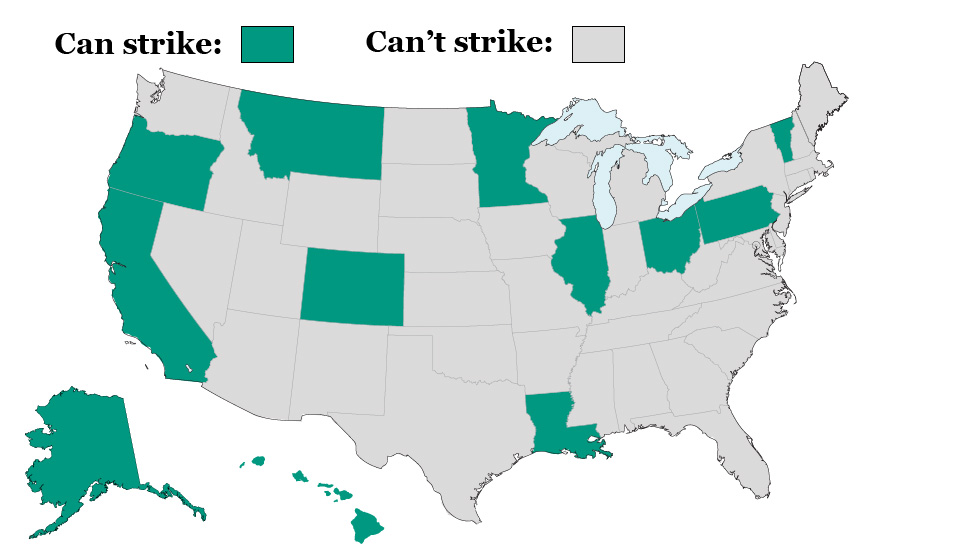Teachers have been talking about the funding crisis, even as legislature after legislature made it harder for them to act. No unions allowed. No strikes allowed. No voices for the teachers allowed — the teachers, who are honestly the only adults in any real numbers who can speak up for underprivileged children in schools. Frequently now, you can lose your license and even retirement for striking. So we simply march forward into classrooms.
And the unseen remains unseen. The people who might stand up for America’s least-fortunate children have become versions of corporate employees, forced to say the politically expedient thing — because speaking up today in many states can cost you your position. They go to work without much voice in the larger world, without the supplies they require, for the sake of their students.
Stop-gap measures provide just enough supplemental funding to shut the protests up in poor, property-tax based districts. Myths of lazy teachers were used to shut down the unions, the principal power that poor school districts could bring into any funding discussion. Myths of self-indulgent teachers are being used now to ignore what teachers are saying about school safety. It takes a fifteen-year-old girl in Georgia with a cell phone to somehow break through the hubris that led to opening all these schools in viral hotspots. Check out the following if you missed this story:
https://www.msn.com/en-us/news/us/9-students-staff-test-positive-for-covid-19-after-georgia-school-hallway-photo-goes-viral/ar-BB17MHNb

Here’s a map that I think should have entered this discussion awhile ago: https://dc.medill.northwestern.edu/blog/2018/03/08/67017/#sthash.VS6OyZ4L.dpbs *

And the years keep going by. In a property-tax based funding system, I bought my own paper, my own ink cartridges and endless writing and art supplies for students. Hell, I bought my own furniture. That tall stool I needed? Only $10 at the Goodwill, a real find. Before computers became widely available — only the last few years, and even then not available to take home except in the high school — I worked in a district that once even toyed with declaring bankruptcy. I expected to buy supplies. I haunted second-hand stores and garage sales. I remember the Walworth County Fair used book sale, where I once got a wonderful set of children’s encyclopedias.
My spouse earned enough so that I could accept my salary. I managed to make everyday life work. That unlockable door? My active shooter plan where we all fled out the middle school’s windows, meeting together some blocks away at a familiar elementary school got my door fixed and a lock installed. I had one or two students who looked like they might not fit easily through those windows, but I was fully prepared to break windows in any shooting scenario. You can find the safest and most effective ways to break windows online, by the way.
Eduhonesty: Those high school hallways in Georgia? Remember your own high school hallways, reader? They all look like the Georgia hallways, except in rare areas with steep enrollment declines. Hallways automatically fill up with wall-to-wall bodies between classes. There’s no way to avoid that glut that does not lose significant class time. Administrators could stagger passing periods but then a 50 minute science period becomes a 30 minute science period — and there are still a bunch of students remaining in the hallway while the bathrooms fill up. I should note, too, that if you create an effective 12 minute passing period, certain students will turn that into a 12 minute bathroom break.
(True story: I worked in a high school with a three-minute passing period. The administration got tired of dealing with referrals for tardiness and instituted a policy that no referrals were to be made until students were at least 10 minutes late. I had a student who kept turning up maybe eight minutes late, day after day. In exasperation, I wrote a referral. He said, “What? No! I get ten minutes!”)
Can’t strike? Most of America’s teachers cannot. Can’t protest? In many places, teachers risk losing their positions if they do. So who is going to advocate for our kids? Fifteen-year-old girls with cell phones? It seems so. We should be extremely glad our kids have cell phones.
Strikes were never simply about teacher salaries, although anti-union voices tried to paint them that way. They were about broken copiers; missing textbooks or software; lack of technology; shortages of supplies; inadequate health insurance; shortages of school nurses for the ill; shortages of paraprofessionals to help special education and bilingual students; lack of equipment for those school nurses and paraprofessionals; student lunches that started at 10:30 AM and ran all day due to lack of space in the cafeteria and the ovens; and work orders that took months to fill or were never filled at all.
Why are some teachers so frantic right now? I want to answer that question: Schools in poorer areas are often held together with string, spit and bailing wire. This situation has been progressively worsening, as we shut down the unions and muzzled the teachers. Those CDC recommendations? I am certain many teachers feel — know — that their district has never had the resources to start a fully-supplied regular year. Those CDC demands?
PIPE DREAMS.
When I had forty students in my class and only 33 desks, we walked down the hall and borrowed from a teacher who had a planning period — for nearly a month. Tall, helpful young men banged desks against door moldings as I gently chided them to be careful. Then we had to get everyone seated and off the radiators.
I am a master of working around broken copiers and computers. But that effort sometimes involves passing out supplies and collecting papers. My colleagues don’t want to collect papers from that kid who coughed all over his work — not right now. I have already taken myself out of the picture. I’m a retired teacher who was substitute teaching until this year. (See https://www.eduhonesty.com/prediction-subs-will-become-an-endangered-species)
Teachers in my last district are lucky. They can actually open windows. In many places, no matter how many students are sniffing and coughing, rooms may have no windows or windows that cannot be opened. Air circulation can be iffy. In unlucky rooms, body odor and perfume combine with subtle smells that sometimes trigger mold allergies.
Some of the problems I list can be avoided in COVID-19 times. No one would stuff 40 students in one room now, right? Reader, I’m not sure. Many schools have been overcrowded for years, adding modules outside and staggering schedules. One year, I worked in an interior converted, concrete storage closet. That room had no ventilation. But at a certain level of crowding, can that converted closet be left empty? Will it be left empty?
Those people saying children must be in school should spend one day in a middle school or high school. They should use a student bathroom, before sitting at a table in the cafeteria. They should take a trip back in time and participate in one of the seven to ten or so passing periods, a number that depends on how much time is spent in each class. That Georgia passing period? That crush of bodies happens over and over again, all day long, every single day.

We are having hybrid school across the country right now. I have written a hybrid post. This post is about coronavirus safety. But it’s also a warning in a time when unions have been struggling against anti-union sentiment. Those teachers who lost their ability to strike? Who can no longer risk speaking up for fear of losing their certification and even their retirement? We need their voices desperately because they can tell the truths that remain unseen.
Unfortunately, over the last few decades, well-orchestrated forces managed to silence those voices. As I write this, I wonder how many people in my country understand what has happened. How many Americans understand the cost of the many voices that fell silent?
We are not talking about self-indulgent people who do not want to work. These are people who love children so much that they are willing to start work with six or more years of education and a masters degree for less than $40,000 per year. They are people who love children so much they will spend hundreds of dollars each year to buy supplies for the students in their classroom. Some spend over $1,000 of their own money. They are people who keep walking back into that classroom, even as the disrespect is hurled on them because — gasp! — they don’t want to step into the line of fire in hopes of a marginal academic advantage over online learning — an advantage apt to be wiped out by the closures and quarantines likely to follow the live classroom experience. Those voices know that in some parts of the country, some high school students are about to get gruesomely ill. A number will die. A greater percentage of older, working adults will die.
Teaching is not a job. It’s a calling. I regard this country as remarkably fortunate. Among other considerations, I think that if the teaching profession were not heavily female, this whole house of cards might collapse. America’s schools would never be able to staff those classrooms. But it’s not collapsing. Women are posting about their anxiety attacks, asking for advice and then going into work.
(According to a study by The World Bank, today 87 percent of American teachers are female and those numbers continue to increase annually.)
https://www.theatlantic.com/education/archive/2019/02/the-explosion-of-women-teachers/582622/ and https://www.thewesterncarolinajournalist.com/2016/05/04/the-history-of-women-as-teachers
I’d like to close this post by suggesting that I understand why we are all afraid of the national strike. They can take your license and even your pension in some states, wiping out your ability to find work at the same time they steal your retirement. That’s scary as hell. Are we at the point where fear is going to rule those interactions between teachers and other stakeholders? Because we are ALL stakeholders in children’s education. Right now, I think that preparations to get back in the classroom will trump attempts to organize and communicate with each other.
When school has begun, and the crazy has quieted down, though, I’d like to suggest teachers revisit the issue of organizing themselves. The internet is a mighty resource. #MeToo women found each other. Teachers can find each other. We can start to fight back and take off these muzzles. We can speak up, understanding that we must be the voices for students in a time when many adults have no idea what the average school day looks like and feels like in underfunded areas. Soap anyone? How many of us bought hand sanitizer before COVID-19 to help those more-fastidious students who were not always lucky enough to find soap in the bathroom?
We need to tell the truths that get buried by nights of grading and week-ends of lesson preparation. We need to revitalize America’s unions so that we don’t have to fear for our jobs when we tell awkward truths that administrators would prefer not to share. They myth of the lazy teacher — they form such a tiny percentage of the field — has been used to silence voices and eliminate tenure in many areas. That’s honestly a travesty of justice.
This country is completely dependent on those 87% of women and 13% of men who are educating its children. If we found each other and worked together, we would form a fiercely powerful force for the betterment of education and worker’s rights. Teachers should not be sacrificed to a greater good tied to a political agenda — especially a political agenda concocted by the same people who brought us 26% of the world’s COVID-19 infections when we have only 4% of the world’s population.
*I strongly recommending checking out this link to learn how West Virginia did an end around legislation that prevented striking. https://dc.medill.northwestern.edu/blog/2018/03/08/67017/#sthash.VS6OyZ4L.dpbs

Pingback: Unions: I Just Dropped In to See What Condition Our Condition Was In | Notes from the Educational Trenches
Pingback: Unions: #RebuildOurUnions and #ReclaimOurVoices | Notes from the Educational Trenches